 |

Trips : Colorado : Great Sand Dunes National Monument
Colorado is more than skiing and mountains. It is also home
to the largest sand dunes in North America! These dunes are located in the southwest
corner of the state, in an area originally reserved as the Great Sand Dune National Monument.
They have added more land to the park since our first visit and it is now known as the
Great Sand Dune National Monument and Reserve.
The area formed due to an interesting configuration of mountains, glaciers, winds, and lots
of time. The dunes formed in a large valley in between two moutain ranges. The valley was
sculpted by a larger glacier thousands of years ago. Interestingly enough, there is still a
large supply of water contained in an underground aquifer in this valley.
When the glacier retreated, it left a number of rivers and streams behind. It also left a
large concentration of really small rocks... some of them small enough to be called sand.
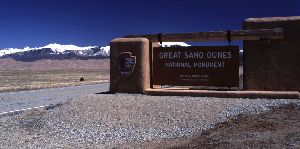 "Park Sign"
Great Sand Dunes National Monument, Colorado
|
One of the things that we do when travelling is take pictures of the park signs. The
primary purpose is to be able to document the area for this web site, or for slide
shows that we present. In this particular case, however, the shot of the park sign
for the Great Sand Dunes National Monument actually saved a roll of film. If you are
interested you can read the story.
If not, read on to hear how these massive sand dunes were created, and why they
still exist today.
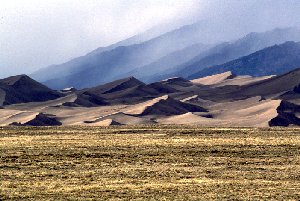 "From a Distance" Great Sand Dunes National Monument, Colorado Big Picture |
The normal winds across the valley run from west to east. These winds rise over the western mountain range, then drop into the valley. As they blow across the valley they pick up sand and other small particles. Once the winds reach the eastern edge of the valley they are forced upwards. At that point they drop the sand particles that they have been carrying.
In the picture shown here you can see the results: massive sand dunes piled up at the base of the mountains. There are 55 acres of sand altogether.
Back to Top
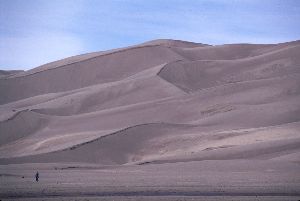 "Dunes Dwarf a Hiker"
Great Sand Dunes National Monument, Colorado
|
These dunes are huge! You can see in the image to the left how they dwarf an unidentified hiker. Can't find him? Look closely at the lower left corner of the picture... that small dark spot on the image is a person...
The dunes are over 700 feet high in places. Core samples have revealed that the dunes (sand) extend down over 100 feet below the ground level as well! That's a lot of sand...
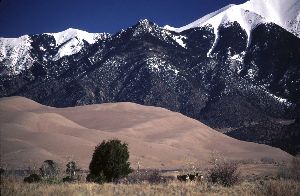 "Deer Among the Dunes"
Great Sand Dunes National Monument, Colorado
|
Despite the inhospitable look to the area, a number of different species of wildlife call the dunes their home. Hiking out into the dunes early in the morning will allow you to find different rodent, deer, and canine tracks. We are not sure if they are coyotes or foxes, but suspect the former.
The image to the side shows some deer grazing on the edge of the dunes. They were probably heading to the river that keeps the dunes from advancing into the mountains.
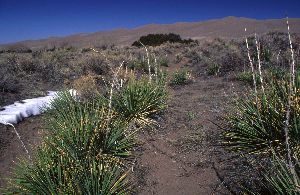 "Life in the Dunes"
Great Sand Dunes National Monument, Colorado
|
Yucca plants are one of the survivors that live on
the edge of the dunes. They don't grow on the dunes themselves.
The dunes are not the best place for plant life. For one thing, many of the dunes move. As the wind blows the dune slowly moves from west to east. But interestingly enough, the largest of the dunes do not move. The two biggest dunes have been around long enough that they actually have names. One is called the High Dune (imaginative name there) and the other is called the Star Dune.
Back to Top
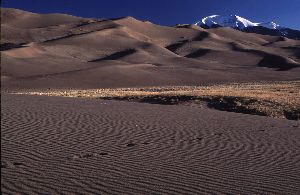 "Footprints in the Dunes" Great Sand Dunes National Monument, Colorado Big Picture |
You are actually allowed to hike or camp on the dunes. Even though they might look like they will fall over at any minute, the dunes are pretty stable once you get down a few inches. The top layers of sand are usually quite dry, but the lower layers are packed and moist. That keeps them pretty solid.
It does, however, provide a unique challenge for hiking. If you are hiking up a steep dune you usually slide back a half step for each step you take forward. My family and I hiked up to the top of the "High Dune" since it was the highest vantage point in the area. From there we were able to look down on all of the other dunes in the park.
The picture to the side shows part of the grassy plains, Mount Herard in the background, and someone's footsteps across the gentle dune...
Back to Top
Since you can hike or camp in the dunes if you like (the only restriction is that you have to camp out of sight from the road) the dunes are open all night. With a tripod and a cable release and a suitable camera you can take longer exposures that actually show the movement of the stars in the sky.
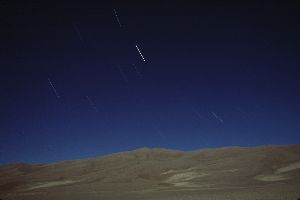 "Star Trails Over Dunes"
Great Sand Dunes National Monument, Colorado
|
It's an interesting technique. In fact, you might not realize just how fast the stars appear to move. For example, the exposure to the left shows some significant star trails with just a thirty minute exposure. If we had stayed out all night, then the stars would have made a circular pattern, with the North Star at the center of the circle.
Our N-70 camera can be set for an exposure for up to 30 seconds. Anything longer than that requires a locking cable release. What does that do? Well, with the camera set appropriately we can plug in a cable and use it to trip the shutter. The cable has a locking mechanism so that the shutter will stay open until it is released. If we need a thirty minute exposure then we just use a watch to time it (for thirty minutes it doesn't much matter if we run over or under by a few seconds).
The exposure above was done during a full moon. The moon itself could not have been in the picture for that long. First of all, it would have washed out (over exposed) the film because it is a really bright light source. The dunes were illuminated purely by moonlight! Second, the stars appear to move only because the Earth is moving. Since both the Earth and the Moon are moving relative to each other, if the moon had been in the photograph it would have moved a lot more than the stars.
Back to Top
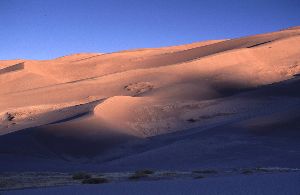 "Morning Sun on the Dunes" Great Sand Dunes National Monument, Colorado Big Picture |
After staying up until midnight to take star trails, we still managed to get back to the park early the next morning. Since there is a mountain range just to the east of the park, there really isn't a way to get a dramatic sunrise picture. The morning sun doesn't even start to touch the dunes until nearly mid-morning.
But, as you can see in the image to the right, the long shadows and glow of the early sun can still be seen.
Great Sand Dunes National Monument provides a unique and interesting experience. If you go, consider camping in the dunes for a truly different vacation. Or, if you would rather have a bed, you can stay in nearby Alamosa, Colorado. Don't forget to check out the bird sanctuary nearby as well.
We hope that you have enjoyed this visual tour of one of the more interesting areas of the state of Colorado.
Back to Top
|
|








|








